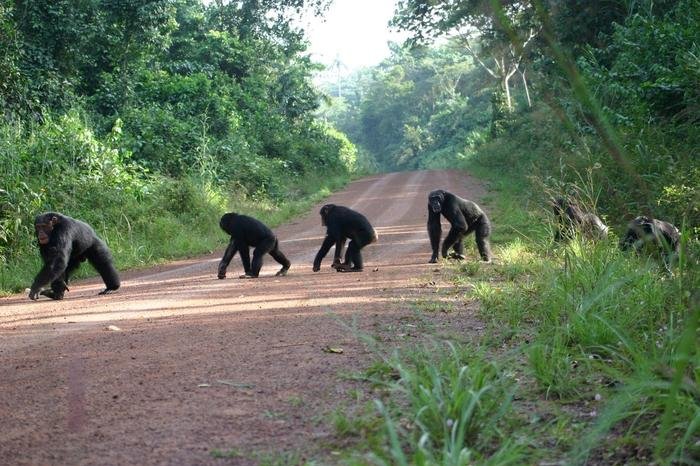According to a new study, chimp density peaks and begins declining around 10 miles away from major roads and four miles from minor roads. Photo by Kimberley Hocking/University of Exeter
Sept. 15 (UPI) -- Roads have a far-ranging impact on chimpanzees across West Africa, not simply displacing them, but significantly reducing their numbers.
According to a new study, published Wednesday in the journal Conservation Letters, a major road's negative impacts on chimpanzee populations can extend up to 10 miles.
With human populations in West Africa growing rapidly, and infrastructure projects following suit, the western chimpanzee's range has become increasing fragmented. Less than 5% is free of "road-effect zones."
"Western chimpanzees were once widespread across West Africa, but the species has declined by 80% in the last 20 years and is currently classified as critically endangered," lead study author Balint Andrasi said in a press release.
"The human population in West Africa is growing rapidly, and chimpanzees face mounting pressure from the expansion of settlements and infrastructure," said Andrasi, a conservation scientist and doctoral student at Exeter University in Britain.
For the study, researchers used data from previous chimpanzee population surveys to model and map the species distribution and density across Ghana, Guinea, Guinea Bissau, Ivory Coast, Liberia, Mali, Senegal and Sierra Leone.
Researchers then overlaid road data from the eight West African countries and used "ecological threshold analysis" to identify the extent of a road's effects on chimpanzee numbers.
The analysis confirmed what previous studies have shown: that roads depress chimpanzee numbers. According to the new study, chimp density peaks and begins declining around 10 miles away from major roads and four miles from minor roads.
While roads themselves are dangerous for all kinds of animals, including chimpanzees, the activities they bring are even more threatening than a speeding vehicle.
"When roads appear, so do all sorts of human activities," Andrasi said.
Roads open up chimpanzee habitats to mining, logging, agriculture and other ecologically destructive activities.
Because regulations in many West African countries require the ecological impacts of infrastructure projects to be considered before breaking ground, the researchers said they hope their work will inspire more thorough and informed environmental review processes -- and perhaps, stronger protections for chimpanzees.
"We hope these findings will ensure the true costs of infrastructure development on the critically endangered western chimpanzee are fully considered by policy makers," said study co-author Kimberley Hockings.
"Our great ape cousins face so many threats, from habitat change to hunting to disease. The impact of infrastructure development is much larger than I ever anticipated and is truly worrying," said Hockings, a researcher at Exeter's Center for Ecology and Conservation.















